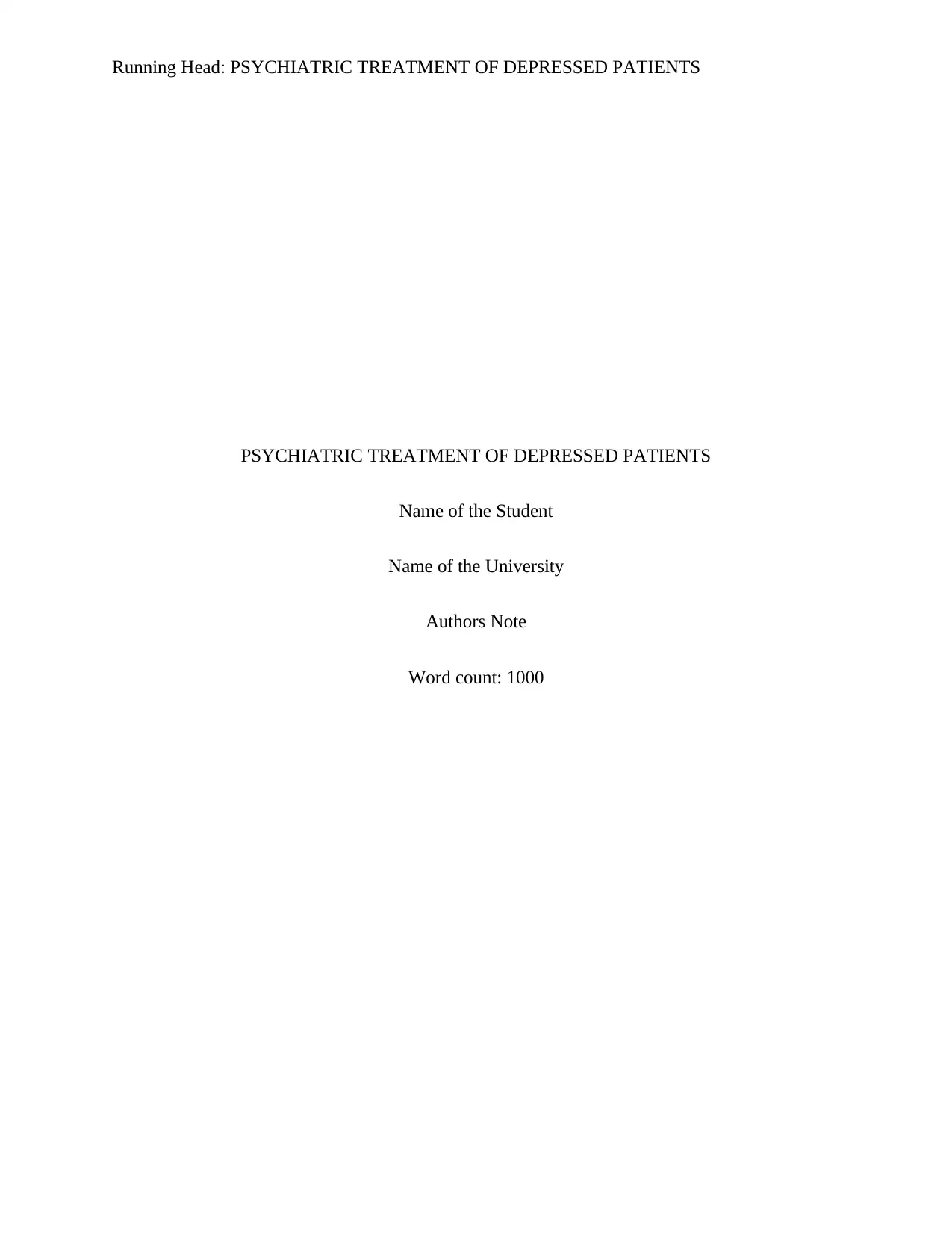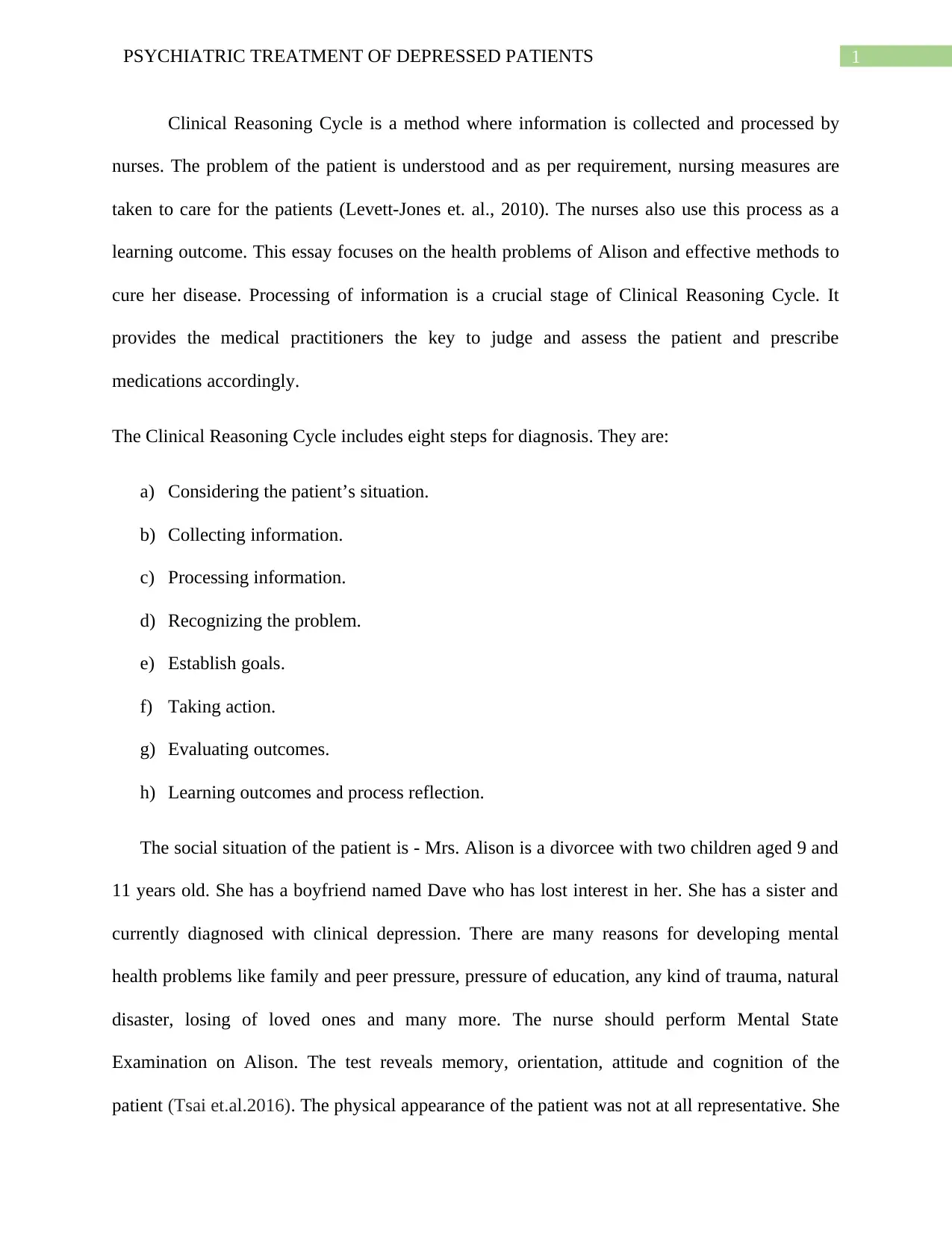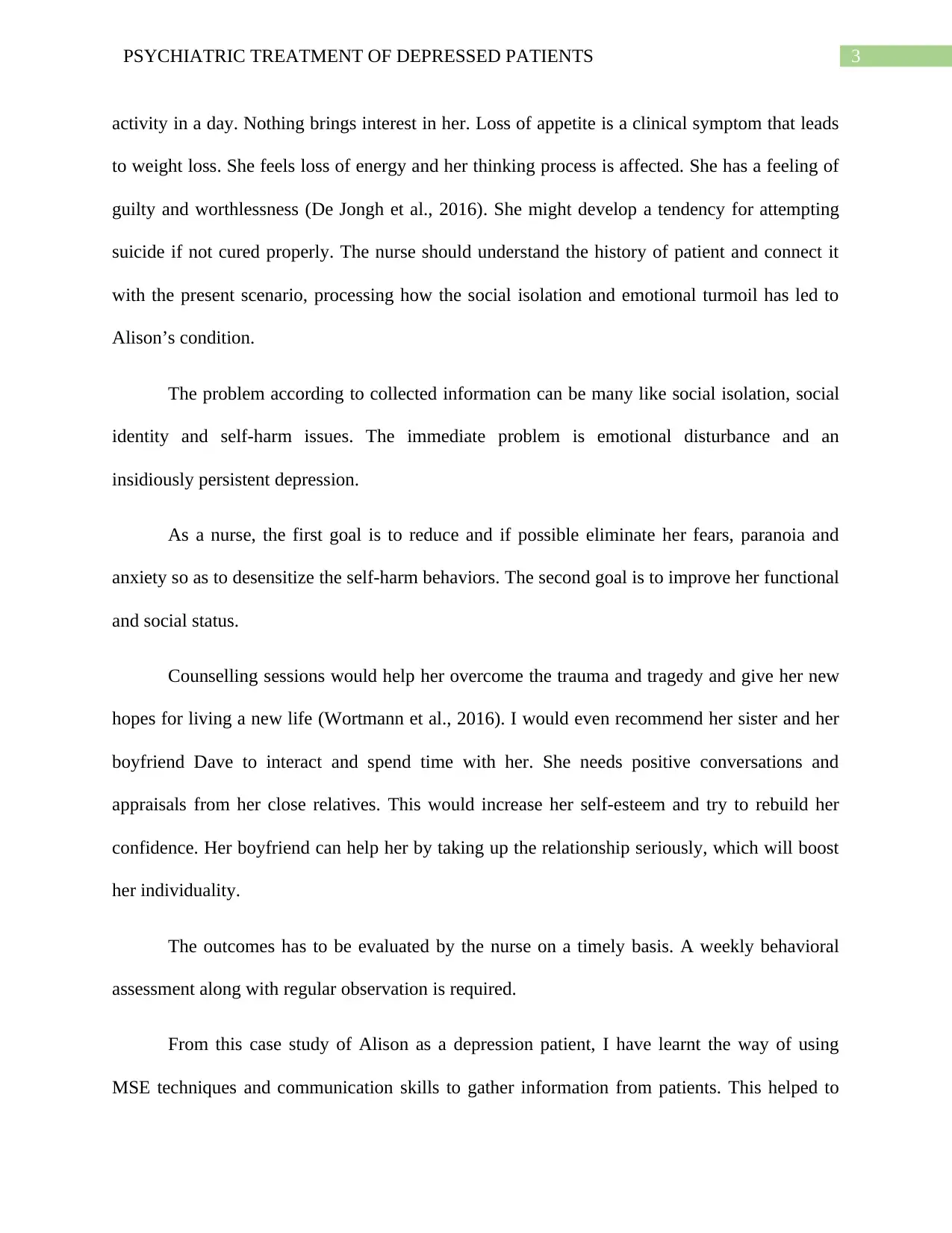Effective Psychiatric Treatment Methods for Depressed Patients
VerifiedAdded on 2022/11/23
|7
|1521
|199
Essay
AI Summary
This essay analyzes the psychiatric treatment of depressed patients, using the case of Alison to illustrate the clinical reasoning cycle. It covers the patient's social situation, mental state examination findings, and the application of DSM-5 diagnostic criteria. The essay emphasizes the importance of collecting and processing information to understand the patient's condition, including social isolation and emotional disturbance. It outlines goals such as reducing anxiety and improving social function, suggesting counseling and social support as key interventions. The nurse's role in assessing outcomes and reflecting on the process is also highlighted, along with the importance of involving the patient's support system. The essay concludes with a reflection on the learning outcomes and the application of MSE techniques and communication skills in developing a treatment plan.

Running Head: PSYCHIATRIC TREATMENT OF DEPRESSED PATIENTS
PSYCHIATRIC TREATMENT OF DEPRESSED PATIENTS
Name of the Student
Name of the University
Authors Note
Word count: 1000
PSYCHIATRIC TREATMENT OF DEPRESSED PATIENTS
Name of the Student
Name of the University
Authors Note
Word count: 1000
Paraphrase This Document
Need a fresh take? Get an instant paraphrase of this document with our AI Paraphraser

1PSYCHIATRIC TREATMENT OF DEPRESSED PATIENTS
Clinical Reasoning Cycle is a method where information is collected and processed by
nurses. The problem of the patient is understood and as per requirement, nursing measures are
taken to care for the patients (Levett-Jones et. al., 2010). The nurses also use this process as a
learning outcome. This essay focuses on the health problems of Alison and effective methods to
cure her disease. Processing of information is a crucial stage of Clinical Reasoning Cycle. It
provides the medical practitioners the key to judge and assess the patient and prescribe
medications accordingly.
The Clinical Reasoning Cycle includes eight steps for diagnosis. They are:
a) Considering the patient’s situation.
b) Collecting information.
c) Processing information.
d) Recognizing the problem.
e) Establish goals.
f) Taking action.
g) Evaluating outcomes.
h) Learning outcomes and process reflection.
The social situation of the patient is - Mrs. Alison is a divorcee with two children aged 9 and
11 years old. She has a boyfriend named Dave who has lost interest in her. She has a sister and
currently diagnosed with clinical depression. There are many reasons for developing mental
health problems like family and peer pressure, pressure of education, any kind of trauma, natural
disaster, losing of loved ones and many more. The nurse should perform Mental State
Examination on Alison. The test reveals memory, orientation, attitude and cognition of the
patient (Tsai et.al.2016). The physical appearance of the patient was not at all representative. She
Clinical Reasoning Cycle is a method where information is collected and processed by
nurses. The problem of the patient is understood and as per requirement, nursing measures are
taken to care for the patients (Levett-Jones et. al., 2010). The nurses also use this process as a
learning outcome. This essay focuses on the health problems of Alison and effective methods to
cure her disease. Processing of information is a crucial stage of Clinical Reasoning Cycle. It
provides the medical practitioners the key to judge and assess the patient and prescribe
medications accordingly.
The Clinical Reasoning Cycle includes eight steps for diagnosis. They are:
a) Considering the patient’s situation.
b) Collecting information.
c) Processing information.
d) Recognizing the problem.
e) Establish goals.
f) Taking action.
g) Evaluating outcomes.
h) Learning outcomes and process reflection.
The social situation of the patient is - Mrs. Alison is a divorcee with two children aged 9 and
11 years old. She has a boyfriend named Dave who has lost interest in her. She has a sister and
currently diagnosed with clinical depression. There are many reasons for developing mental
health problems like family and peer pressure, pressure of education, any kind of trauma, natural
disaster, losing of loved ones and many more. The nurse should perform Mental State
Examination on Alison. The test reveals memory, orientation, attitude and cognition of the
patient (Tsai et.al.2016). The physical appearance of the patient was not at all representative. She

2PSYCHIATRIC TREATMENT OF DEPRESSED PATIENTS
had short hair with dull clothing. Her hair was not tidy and her body language was clumsy. Her
attitude was non-oriented. She was not being able to maintain an eye contact with the nurse,
which revealed that she was shy. She was low-spirited and her speech was nearly inaudible. She
was very sad and tearful and she lacked focus in the interview. Analyzing the video, it was found
that although she was answering all the questions in a hesitant manner and was quite nervous,
but she remembered all the sequence of events, which happened about four years ago when she
got divorced. It also came into light that she took few attempts of suicide earlier in life because
of depression. Mentally she was socially isolated and lacked a complete social identity. She was
intelligent as she accepted her sister’s advice and consulted a nurse.
Collecting information both qualitative and quantitative is important. Depression,
nowadays, is a very common mental disorder. It is characterized by low mood and sadness.
There is lack of interest in activities that people normally used to enjoy. This character was also
present in Alison, which confirmed that she was a patient of depression. In order to plan for a
mental health plan for Alison, the nurse should comply with her socio and economic condition.
She finds out that Alison was paid low wages in the supermarket where she works. She was not
able to meet her kids’ needs due to financial crisis. This also added to her depression. Moreover,
her relationship with her boyfriend was not good as Dave was not serious with the relationship
and she feels stressed. The nurse needs to process the information then.
There are eight diagnostic criteria of DSM 5 for assessing clinical depression. The
individual must experience at least five symptoms for a span of at least two weeks for DSM 5 to
be diagnosed (Depression Definition and DSM-5 Diagnostic Criteria, 2019). The patient should
have suffered from depressed mood for maximum time in a day or whole day. Her interests have
diminished in the places and situations that used to get pleasure. She is fed up doing any type of
had short hair with dull clothing. Her hair was not tidy and her body language was clumsy. Her
attitude was non-oriented. She was not being able to maintain an eye contact with the nurse,
which revealed that she was shy. She was low-spirited and her speech was nearly inaudible. She
was very sad and tearful and she lacked focus in the interview. Analyzing the video, it was found
that although she was answering all the questions in a hesitant manner and was quite nervous,
but she remembered all the sequence of events, which happened about four years ago when she
got divorced. It also came into light that she took few attempts of suicide earlier in life because
of depression. Mentally she was socially isolated and lacked a complete social identity. She was
intelligent as she accepted her sister’s advice and consulted a nurse.
Collecting information both qualitative and quantitative is important. Depression,
nowadays, is a very common mental disorder. It is characterized by low mood and sadness.
There is lack of interest in activities that people normally used to enjoy. This character was also
present in Alison, which confirmed that she was a patient of depression. In order to plan for a
mental health plan for Alison, the nurse should comply with her socio and economic condition.
She finds out that Alison was paid low wages in the supermarket where she works. She was not
able to meet her kids’ needs due to financial crisis. This also added to her depression. Moreover,
her relationship with her boyfriend was not good as Dave was not serious with the relationship
and she feels stressed. The nurse needs to process the information then.
There are eight diagnostic criteria of DSM 5 for assessing clinical depression. The
individual must experience at least five symptoms for a span of at least two weeks for DSM 5 to
be diagnosed (Depression Definition and DSM-5 Diagnostic Criteria, 2019). The patient should
have suffered from depressed mood for maximum time in a day or whole day. Her interests have
diminished in the places and situations that used to get pleasure. She is fed up doing any type of
⊘ This is a preview!⊘
Do you want full access?
Subscribe today to unlock all pages.

Trusted by 1+ million students worldwide

3PSYCHIATRIC TREATMENT OF DEPRESSED PATIENTS
activity in a day. Nothing brings interest in her. Loss of appetite is a clinical symptom that leads
to weight loss. She feels loss of energy and her thinking process is affected. She has a feeling of
guilty and worthlessness (De Jongh et al., 2016). She might develop a tendency for attempting
suicide if not cured properly. The nurse should understand the history of patient and connect it
with the present scenario, processing how the social isolation and emotional turmoil has led to
Alison’s condition.
The problem according to collected information can be many like social isolation, social
identity and self-harm issues. The immediate problem is emotional disturbance and an
insidiously persistent depression.
As a nurse, the first goal is to reduce and if possible eliminate her fears, paranoia and
anxiety so as to desensitize the self-harm behaviors. The second goal is to improve her functional
and social status.
Counselling sessions would help her overcome the trauma and tragedy and give her new
hopes for living a new life (Wortmann et al., 2016). I would even recommend her sister and her
boyfriend Dave to interact and spend time with her. She needs positive conversations and
appraisals from her close relatives. This would increase her self-esteem and try to rebuild her
confidence. Her boyfriend can help her by taking up the relationship seriously, which will boost
her individuality.
The outcomes has to be evaluated by the nurse on a timely basis. A weekly behavioral
assessment along with regular observation is required.
From this case study of Alison as a depression patient, I have learnt the way of using
MSE techniques and communication skills to gather information from patients. This helped to
activity in a day. Nothing brings interest in her. Loss of appetite is a clinical symptom that leads
to weight loss. She feels loss of energy and her thinking process is affected. She has a feeling of
guilty and worthlessness (De Jongh et al., 2016). She might develop a tendency for attempting
suicide if not cured properly. The nurse should understand the history of patient and connect it
with the present scenario, processing how the social isolation and emotional turmoil has led to
Alison’s condition.
The problem according to collected information can be many like social isolation, social
identity and self-harm issues. The immediate problem is emotional disturbance and an
insidiously persistent depression.
As a nurse, the first goal is to reduce and if possible eliminate her fears, paranoia and
anxiety so as to desensitize the self-harm behaviors. The second goal is to improve her functional
and social status.
Counselling sessions would help her overcome the trauma and tragedy and give her new
hopes for living a new life (Wortmann et al., 2016). I would even recommend her sister and her
boyfriend Dave to interact and spend time with her. She needs positive conversations and
appraisals from her close relatives. This would increase her self-esteem and try to rebuild her
confidence. Her boyfriend can help her by taking up the relationship seriously, which will boost
her individuality.
The outcomes has to be evaluated by the nurse on a timely basis. A weekly behavioral
assessment along with regular observation is required.
From this case study of Alison as a depression patient, I have learnt the way of using
MSE techniques and communication skills to gather information from patients. This helped to
Paraphrase This Document
Need a fresh take? Get an instant paraphrase of this document with our AI Paraphraser

4PSYCHIATRIC TREATMENT OF DEPRESSED PATIENTS
develop a provisional prescription and treatment plan for the patient. The clinical reasoning cycle
steps are also used for nursing intervention. As a nurse, I would like to have a session with her
boyfriend and sister. They are most close people to Alison who can help to recover her from the
disease. She needs to interact with social groups in her neighborhood so that she get out of her
isolation. As a nurse, I would help her getting enrolled in certain social activity groups which
would make her busy (Moorhead et. al., 2018). This would occupy her mind and thought and she
would not have any time left for thinking past memories.
develop a provisional prescription and treatment plan for the patient. The clinical reasoning cycle
steps are also used for nursing intervention. As a nurse, I would like to have a session with her
boyfriend and sister. They are most close people to Alison who can help to recover her from the
disease. She needs to interact with social groups in her neighborhood so that she get out of her
isolation. As a nurse, I would help her getting enrolled in certain social activity groups which
would make her busy (Moorhead et. al., 2018). This would occupy her mind and thought and she
would not have any time left for thinking past memories.

5PSYCHIATRIC TREATMENT OF DEPRESSED PATIENTS
References:
American Psychiatric Association. (2013). Diagnostic and statistical manual of mental disorders
(DSM-5®). American Psychiatric Pub.
De Jongh, A., Resick, P. A., Zoellner, L. A., Van Minnen, A., Lee, C. W., Monson, C. M., ... &
Rauch, S. A. (2016). Critical analysis of the current treatment guidelines for complex
PTSD in adults. Depression and Anxiety, 33(5), 359-369.
Depression Definition and DSM-5 Diagnostic Criteria. (2019). Depression Definition and DSM-
5 Diagnostic Criteria. Retrieved from https://www.psycom.net/depression-definition-
dsm-5-diagnostic-criteria/
Levett-Jones, T., Hoffman, K., Dempsey, J., Jeong, S. Y. S., Noble, D., Norton, C. A., ... &
Hickey, N. (2010). The ‘five rights’ of clinical reasoning: An educational model to
enhance nursing students’ ability to identify and manage clinically ‘at
risk’patients. Nurse education today, 30(6), 515-520.
Moorhead, S., Johnson, M., Maas, M. L., & Swanson, E. (2018). Nursing Outcomes
Classification (NOC)-E-Book: Measurement of Health Outcomes. Elsevier Health
Sciences.
Tsai, J.C., Chen, C.W.,Chu,H., Yang,H.L., Chung,M.L., Liao,Y.M. & Chou,K.R, (2016).
Comparing the Sensitivity, Specificity, and Predictive Values of the Montreal Cognitive
Assessment and Mini-Mental State Examination When Screening People for Mild
Cognitive Impairment, dementia and depression in Chinese Population. Archives of
Psychiatric Nursing, 30(4), 486-491. DOI: 10.1016/j.apnu.2016.01.015
References:
American Psychiatric Association. (2013). Diagnostic and statistical manual of mental disorders
(DSM-5®). American Psychiatric Pub.
De Jongh, A., Resick, P. A., Zoellner, L. A., Van Minnen, A., Lee, C. W., Monson, C. M., ... &
Rauch, S. A. (2016). Critical analysis of the current treatment guidelines for complex
PTSD in adults. Depression and Anxiety, 33(5), 359-369.
Depression Definition and DSM-5 Diagnostic Criteria. (2019). Depression Definition and DSM-
5 Diagnostic Criteria. Retrieved from https://www.psycom.net/depression-definition-
dsm-5-diagnostic-criteria/
Levett-Jones, T., Hoffman, K., Dempsey, J., Jeong, S. Y. S., Noble, D., Norton, C. A., ... &
Hickey, N. (2010). The ‘five rights’ of clinical reasoning: An educational model to
enhance nursing students’ ability to identify and manage clinically ‘at
risk’patients. Nurse education today, 30(6), 515-520.
Moorhead, S., Johnson, M., Maas, M. L., & Swanson, E. (2018). Nursing Outcomes
Classification (NOC)-E-Book: Measurement of Health Outcomes. Elsevier Health
Sciences.
Tsai, J.C., Chen, C.W.,Chu,H., Yang,H.L., Chung,M.L., Liao,Y.M. & Chou,K.R, (2016).
Comparing the Sensitivity, Specificity, and Predictive Values of the Montreal Cognitive
Assessment and Mini-Mental State Examination When Screening People for Mild
Cognitive Impairment, dementia and depression in Chinese Population. Archives of
Psychiatric Nursing, 30(4), 486-491. DOI: 10.1016/j.apnu.2016.01.015
⊘ This is a preview!⊘
Do you want full access?
Subscribe today to unlock all pages.

Trusted by 1+ million students worldwide

6PSYCHIATRIC TREATMENT OF DEPRESSED PATIENTS
Wortmann, J. H., Jordan, A. H., Weathers, F. W., Resick, P. A., Dondanville, K. A., Hall-Clark,
B., ... & Mintz, J. (2016). Psychometric analysis of the PTSD Checklist-5 (PCL-5) among
treatment-seeking military service members. Psychological assessment, 28(11), 1392.
Wortmann, J. H., Jordan, A. H., Weathers, F. W., Resick, P. A., Dondanville, K. A., Hall-Clark,
B., ... & Mintz, J. (2016). Psychometric analysis of the PTSD Checklist-5 (PCL-5) among
treatment-seeking military service members. Psychological assessment, 28(11), 1392.
1 out of 7
Related Documents
Your All-in-One AI-Powered Toolkit for Academic Success.
+13062052269
info@desklib.com
Available 24*7 on WhatsApp / Email
![[object Object]](/_next/static/media/star-bottom.7253800d.svg)
Unlock your academic potential
Copyright © 2020–2025 A2Z Services. All Rights Reserved. Developed and managed by ZUCOL.





